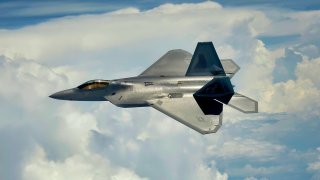The Air Force Has Few F-22 Raptor Fighters (One Just Got Messed Up)
A Lockheed Martin F-22 Raptor experienced a nose gear issue upon landing at Kadena Air Base in Okinawa, marking a less-than-ideal return of the aircraft to the Indo-Pacific region.
Summary: A Lockheed Martin F-22 Raptor experienced a nose gear issue upon landing at Kadena Air Base in Okinawa, marking a less-than-ideal return of the aircraft to the Indo-Pacific region. The incident, part of a pattern of similar problems affecting both the F-22 and F-35 fleets, highlights ongoing concerns about the reliability of landing gear in advanced fighter jets. Despite these challenges, the deployment of the F-22s, including the affected aircraft from the 19th Fighter Squadron based in Honolulu, underscores the strategic importance of Okinawa as a key location for maintaining regional stability and readiness for the U.S. Air Force.
F-22 Raptor Faces Landing Gear Malfunction Upon Return to Indo-Pacific
It wasn't how the United States Air Force wanted to mark the return of the Lockheed Martin F-22 Raptor to the Indo-Pacific. One of the fifth-generation air superiority fighters suffered a nose gear issue after arriving at Kadena Air Base, Okinawa, on Friday.
"The Raptor was in an accident," was how one user on X – the social media platform formerly known as Twitter – captioned a photo of an F-22 being towed off the tarmac.
According to reports, the incident occurred after the F-22 landed at Kadena Air Base. The malfunction occurred while it was being maneuvered off the runway with its engines turned off. However, emergency vehicles, including a fire engine, responded as part of the regular protocol.
"This is not an isolated occurrence for the F-22 fleet. Similar landing gear issues have been documented in the past, affecting not just the F-22 but also its fifth-generation counterpart, the F-35, which has seen its variety of gear failures. The latter includes incidents where F-35 aircraft have experienced nose gear malfunctions both on the ground and during operation," Ytechnews.com reported.
It further noted that there have been recurring problems with the landing apparatus of sophisticated fighter jets, including the F-22 and F-35, which have raised questions about the mechanical robustness of such essential equipment.
In March 2022, an F-22 Raptor suffered a landing gear mishap at Eglin Air Force Base (AFB), Florida. A year earlier, in March 2021, another Raptor had an in-flight emergency and landed safely but suffered a nose gear collapse on the runway.
There have been multiple nose gear troubles with the F-35 Lightning II, including an incident in January of this year when an F-35C assigned to Marine Fighter Attack Squadron (VMFA) 311 at Marine Corps Air Station Miramar, California suffered a nose landing gear collapse while parked shortly after a training mission at Naval Air Station Fallon, Nevada.
"These incidents serve as critical reminders of the importance of exhaustive testing and maintenance to ensure the reliability and safety of front-line combat aircraft," Ytechnews' commentary added.
The F-22 Back in the Keystone of the Pacific
The F-22 Raptor fighter involved in Friday's incident is part of the 19th Fighter Squadron, 15th Wing, stationed at Hickam Air Force Base in Honolulu, Hawaii. It was among several Raptors that had been temporarily deployed to Okinawa on April 5, 2024, to ensure readiness in the region.
The incident also comes just days after U.S. Air Force Secretary Frank Kendall, Chief of Staff Gen. David Allvin, and Chief Master Sergeant David Flosi visited Kadena, and highlighted its importance as the "Keystone of the Pacific."
Okinawa, with its extensive network of air bases and naval facilities, plays a pivotal role in maintaining regional stability and safeguarding vital maritime and aerial routes. It is roughly 900 miles from Tokyo, Manila, Seoul, and Hong Kong and 1,200 miles west of Guam, the American territory that serves as a critical hub for U.S. military operations in the region.
Author Experience and Expertise: Peter Suciu
Peter Suciu is a Michigan-based writer. He has contributed to more than four dozen magazines, newspapers, and websites with over 3,200 published pieces over a twenty-year career in journalism. He regularly writes about military hardware, firearms history, cybersecurity, politics, and international affairs. Peter is also a Contributing Writer for Forbes and Clearance Jobs. You can follow him on Twitter: @PeterSuciu.
You can email the author: [email protected].


